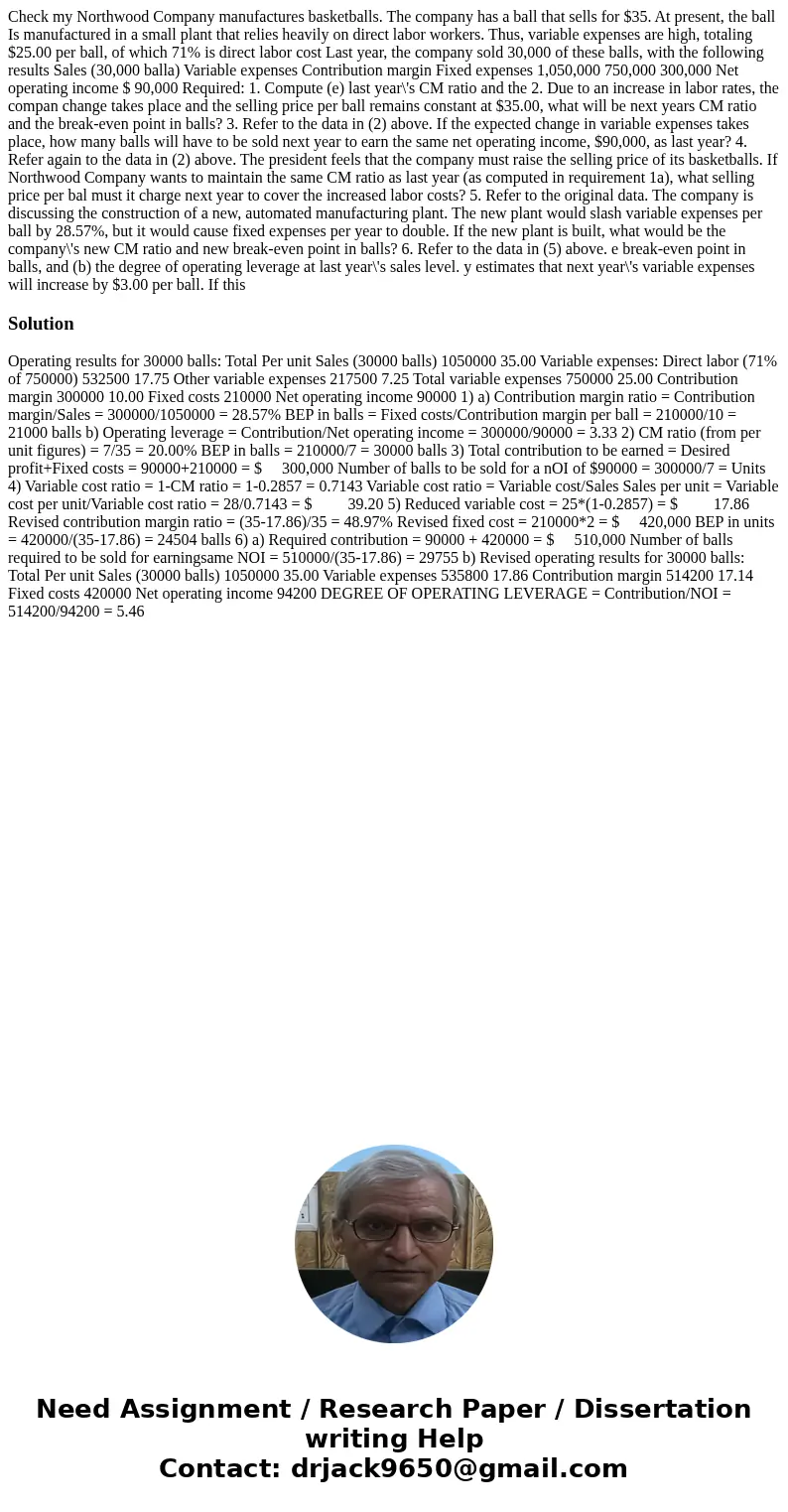Check my Northwood Company manufactures basketballs The comp
Check my Northwood Company manufactures basketballs. The company has a ball that sells for $35. At present, the ball Is manufactured in a small plant that relies heavily on direct labor workers. Thus, variable expenses are high, totaling $25.00 per ball, of which 71% is direct labor cost Last year, the company sold 30,000 of these balls, with the following results Sales (30,000 balla) Variable expenses Contribution margin Fixed expenses 1,050,000 750,000 300,000 Net operating income $ 90,000 Required: 1. Compute (e) last year\'s CM ratio and the 2. Due to an increase in labor rates, the compan change takes place and the selling price per ball remains constant at $35.00, what will be next years CM ratio and the break-even point in balls? 3. Refer to the data in (2) above. If the expected change in variable expenses takes place, how many balls will have to be sold next year to earn the same net operating income, $90,000, as last year? 4. Refer again to the data in (2) above. The president feels that the company must raise the selling price of its basketballs. If Northwood Company wants to maintain the same CM ratio as last year (as computed in requirement 1a), what selling price per bal must it charge next year to cover the increased labor costs? 5. Refer to the original data. The company is discussing the construction of a new, automated manufacturing plant. The new plant would slash variable expenses per ball by 28.57%, but it would cause fixed expenses per year to double. If the new plant is built, what would be the company\'s new CM ratio and new break-even point in balls? 6. Refer to the data in (5) above. e break-even point in balls, and (b) the degree of operating leverage at last year\'s sales level. y estimates that next year\'s variable expenses will increase by $3.00 per ball. If this 
Solution
Operating results for 30000 balls: Total Per unit Sales (30000 balls) 1050000 35.00 Variable expenses: Direct labor (71% of 750000) 532500 17.75 Other variable expenses 217500 7.25 Total variable expenses 750000 25.00 Contribution margin 300000 10.00 Fixed costs 210000 Net operating income 90000 1) a) Contribution margin ratio = Contribution margin/Sales = 300000/1050000 = 28.57% BEP in balls = Fixed costs/Contribution margin per ball = 210000/10 = 21000 balls b) Operating leverage = Contribution/Net operating income = 300000/90000 = 3.33 2) CM ratio (from per unit figures) = 7/35 = 20.00% BEP in balls = 210000/7 = 30000 balls 3) Total contribution to be earned = Desired profit+Fixed costs = 90000+210000 = $ 300,000 Number of balls to be sold for a nOI of $90000 = 300000/7 = Units 4) Variable cost ratio = 1-CM ratio = 1-0.2857 = 0.7143 Variable cost ratio = Variable cost/Sales Sales per unit = Variable cost per unit/Variable cost ratio = 28/0.7143 = $ 39.20 5) Reduced variable cost = 25*(1-0.2857) = $ 17.86 Revised contribution margin ratio = (35-17.86)/35 = 48.97% Revised fixed cost = 210000*2 = $ 420,000 BEP in units = 420000/(35-17.86) = 24504 balls 6) a) Required contribution = 90000 + 420000 = $ 510,000 Number of balls required to be sold for earningsame NOI = 510000/(35-17.86) = 29755 b) Revised operating results for 30000 balls: Total Per unit Sales (30000 balls) 1050000 35.00 Variable expenses 535800 17.86 Contribution margin 514200 17.14 Fixed costs 420000 Net operating income 94200 DEGREE OF OPERATING LEVERAGE = Contribution/NOI = 514200/94200 = 5.46
 Homework Sourse
Homework Sourse